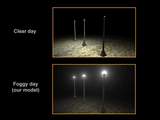
|
|
We are interested in analyzing and rendering the visual effects due to
scattering of light by participating media such as fog, mist and haze.
While a number of sophisticated approaches based on Monte Carlo and finite
element simulation have been developed, these approaches are
computationally very expensive. In the context of rendering, the most
common real-time methods are essentially simple variants of the OpenGL fog
model. While easy to use and specify, the OpenGL fog model excludes many
important qualitative effects like glows around light sources, the effect of volumetric scattering on the appearance of surfaces such as the diffusing of glossy highlights and the appearance of objects under complex lighting such as environment maps. In this project, we have developed a new physically based model for single scattering that captures these effects while maintaining the real-time performance and the ease-of-use of the OpenGL fog model. Our model is based on an explicit analytic integration of the single scattering light transport equations for an isotropic point light source in a homogeneous participating medium. We have implemented the model in modern programmable graphics hardware using a few small numerical lookup tables stored as texture maps. Our model can also be easily adapted to generate the appearances of materials with arbitrary BRDFs, environment map lighting and pre-computed radiance transfer methods, in the presence of participating media. This project is done in collaboration with Ravi Ramamoorthi and Shree Nayar at Columbia University. |
Publications
"A Practical Analytic Single Scattering Model for Real Time Rendering,"
B. Sun, R. Ramamoorthi, S.G. Narasimhan and S.K. Nayar,
ACM Trans. on Graphics (also Proc. of ACM SIGGRAPH),
August 2005.
[PDF]
|
Videos
(Video Result Playlist)
 |
SIGGRAPH 2005 Video:
This video shows all our examples of interactive real-time rendering of single scattering effects using our analytic models. (With narration)
|
 |
Airlight Model:
Our airlight model captures effects like glows around light sources which is shown in this video of a scene with street lamps. (With narration)
|
 |
Surface Radiance Model:
Our model can also be used to compute the effects on surface appearance due to scattering for the first time. In this video, you will see effects like diffusing of highlights due to scattering as well as overall dimming of the scene due to attenuation. (With narration)
|
 |
Scattering with PRT:
Our method can also be applied to complex lighting and can be used to incorporate scattering effects into any existing environment mapping method such as precomputed radiance transfer (PRT). (With narration)
|
|
Data and Downloads
Download from here
|
|